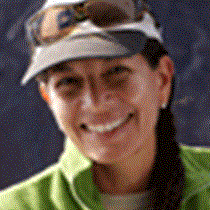Floreana Island was named after Juan Jose Flores, the first president of Ecuador, during whose administration in 1832 the government of Ecuador took possession of the archipelago. It was previously called Charles Island (after King Charles II of England) and Santa Maria after one of the caravels of Columbus.
The island has an area of 173 square kilometers (67 sq mi). It was formed by volcanic eruption. The island's highest point is Cerro Pajas at 640 meters (2,100 ft), and was one of the 4 islands that Charles Darwin visited in 1835.
Before breakfast, we went ashore on Punta Cormorant, with a beach or green color for the presence of olivine crystals. The trail took us inland passing by a brackish lagoon where a flamingo was spotted with a young one! Endemic and native vegetation surrounded us until we reached a second beach of incredibly fine, white, coralline sand, a favorite nesting site for green sea turtles. Some tracks were still fresh, meaning that turtle nesting activities are not over at this time of the year.
Later on and after breakfast, our captain repositioned the ship near Champion Islet. This is a volcanic cone, now eroded, with rocky shores, home to sea birds and Galapagos sea lions, but also home to the remnant population of the Floreana mockingbird, which was driven to extinction by cats, rats, and other introduced predators on the main island. To control these invasive species and to restore the ecosystem of Floreana, an ambitious restoration program is underway, the Galapagos Verde 2050. Through the Lindblad-National Geographic Fund, our guests can play an important role in the restoration of these habitats.
We explored the islet by Zodiacs in the search of these rare and unique birds (which inspired Darwin in the formulation of his theory of evolution through natural selection) and the rest of the morning we devoted to enjoying the water realms from our glass-bottom boat or by snorkeling.
Following lunch, we spent the afternoon visiting the famous Post Office Bay. This famous landmark was first mentioned in 1793 by British Captain James Colnett and is still use to mail letters with no stamps required! Then we had the chance to explore the bay by Zodiac or by kayas, encountering many sea turtles, rays, and playful sea lions. Our guests were so happy to be here!







